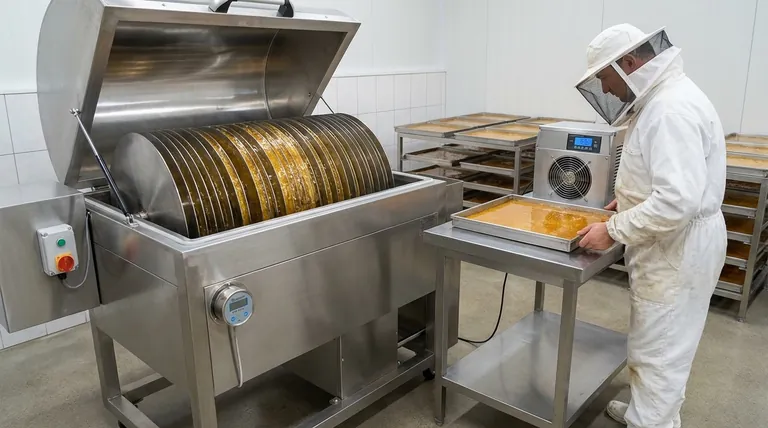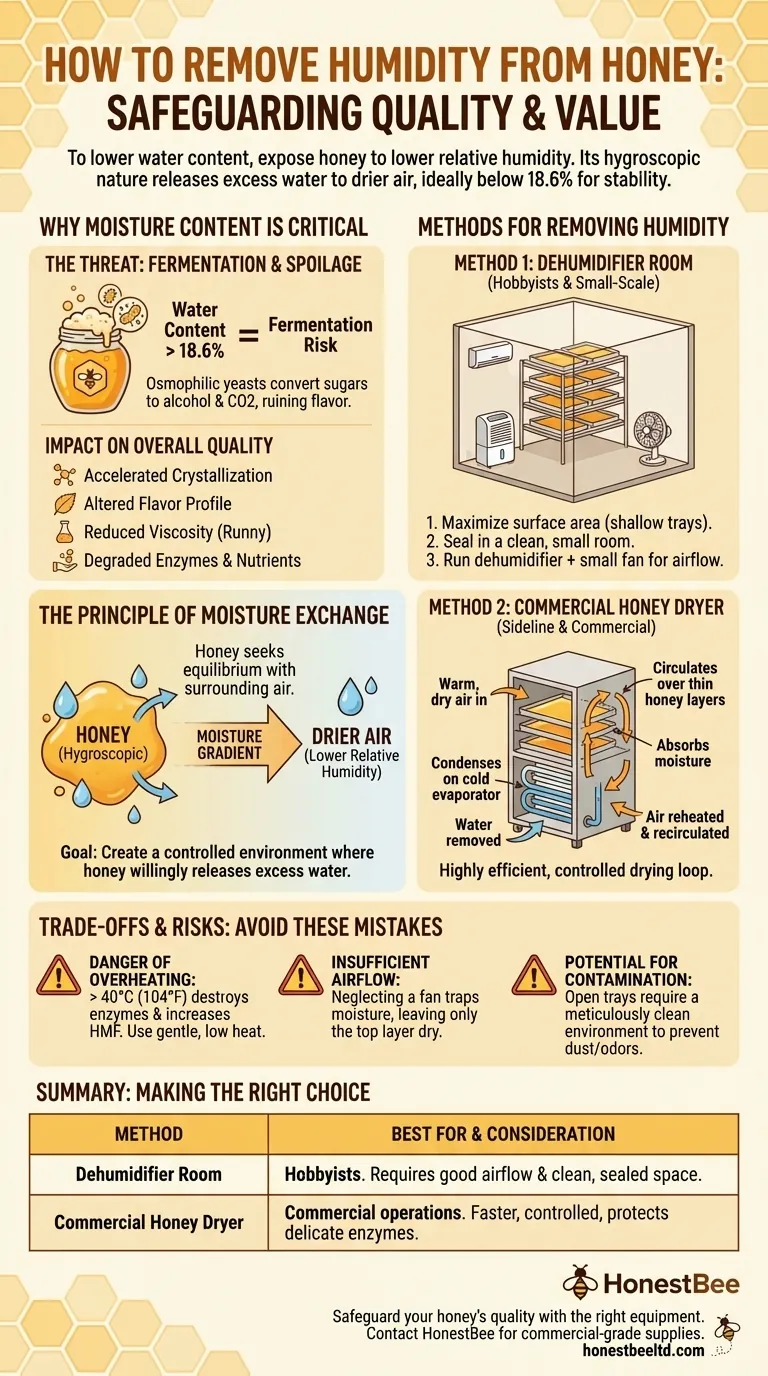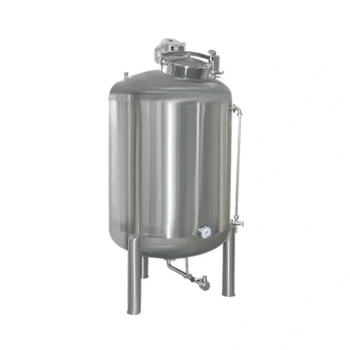To lower the water content of honey, you must expose it to an environment with a lower relative humidity, a process driven by honey's natural properties. This is typically achieved using a room with a consumer dehumidifier or a specialized commercial honey dryer. Because honey is hygroscopic, it will naturally release its excess water into the drier surrounding air until it reaches a stable, safe moisture concentration (ideally below 18.6%).
High moisture content is the primary threat to your honey harvest, leading to fermentation and spoilage by naturally occurring yeasts. The goal is not merely to dry the honey, but to create a controlled environment where it can safely release its excess water without damaging its delicate enzymes and flavor profile.

Why Moisture Content is Critical in Honey
Uncapped or "green" honey often contains excess water that makes it unstable. Understanding the risks is the first step toward protecting your harvest.
The Primary Risk: Fermentation
Honey with a water content above approximately 18.6% is susceptible to fermentation. Naturally present osmophilic yeasts can become active in this high-moisture environment, converting the honey's sugars into alcohol and carbon dioxide. This process ruins the flavor and makes the honey unsellable.
The Impact on Overall Quality
Excess moisture degrades honey in several other ways. It can accelerate crystallization, alter the natural flavor profile, reduce viscosity (making it runny), and degrade beneficial enzymes and nutrients sensitive to microbial activity.
The Principle of Moisture Exchange
Removing humidity from honey is a process of passive environmental control. You are not actively "pulling" water out, but rather creating conditions where the honey gives it up willingly.
Honey's Hygroscopic Nature
Honey is hygroscopic, meaning it seeks to equalize its moisture content with the surrounding air. If the air is more humid than the honey, the honey will absorb water. If the air is drier than the honey, the honey will release water. This is the core principle you will manipulate.
Creating a Moisture Gradient
The goal is to create a moisture gradient where the relative humidity of the air is significantly lower than the water content of the honey. This encourages water molecules to leave the honey and enter the air, effectively drying it.
Methods for Removing Humidity
The method you choose depends on your scale and the level of control you require. Both methods described below rely on creating the moisture gradient.
Method 1: The Dehumidifier Room
For hobbyists or small-scale operations, a sealed room with a dehumidifier is a practical and cost-effective solution.
- Prepare the Honey: Pour the honey into shallow, food-safe trays or pans. Maximizing the surface area is critical for efficient moisture exchange.
- Seal the Space: Place the trays in a small, clean, and sealable room. A walk-in closet or small pantry works well.
- Control the Environment: Run a consumer dehumidifier in the sealed room. Add a small fan, set on low, to gently circulate the air over the honey's surface. This constant airflow prevents a static layer of moist air from forming over the honey and speeds up the process.
Method 2: The Commercial Honey Dryer
For sideline or commercial beekeepers, a dedicated honey dryer provides greater speed and control. These units work on a more advanced condensation principle.
Warm, dry air is circulated over thin layers of honey, where it absorbs the evaporated moisture. This newly moist air is then drawn across a cold evaporator, causing the water to condense and be removed from the system. The now-dry air is reheated and recirculated, creating a highly efficient drying loop.
Understanding the Trade-offs and Risks
While drying honey is necessary, improper technique can cause its own set of problems. Objectivity requires acknowledging these risks.
The Danger of Overheating
Honey is sensitive to heat. Using "warm air" to speed up drying is a significant risk. Excessive heat (typically above 40°C or 104°F) will destroy valuable enzymes like diastase and invertase and can produce undesirable compounds like HMF (hydroxymethylfurfural), which degrades quality. Gentle, low-temperature air is always superior.
Insufficient Airflow
A common mistake with the dehumidifier room method is neglecting airflow. Without a fan to circulate air, only the very top layer of honey will dry. The rest of the batch will remain stagnant, trapping moisture and defeating the purpose of the setup.
Potential for Contamination
Drying honey in open trays exposes it to airborne contaminants. The room must be meticulously clean to prevent dust, debris, or foreign odors from being absorbed into the honey.
Making the Right Choice for Your Goal
Your primary objective will determine the best approach for protecting your honey's quality and value.
- If your primary focus is processing a small, personal harvest: The dehumidifier room method is effective, accessible, and sufficient for ensuring your honey is stable for storage.
- If your primary focus is efficiency and consistency for a commercial operation: A dedicated honey dryer is a worthwhile investment, offering superior control and speed to protect a larger, more valuable product.
By actively managing your honey's moisture content, you are not just preserving it; you are safeguarding its quality and value.
Summary Table:
| Method | Best For | Key Consideration |
|---|---|---|
| Dehumidifier Room | Hobbyists & Small-Scale | Requires good airflow and a sealed, clean space. |
| Commercial Honey Dryer | Sideline & Commercial Beekeepers | Faster, more controlled process; protects delicate enzymes. |
Safeguard your honey's quality and profitability with the right equipment.
For commercial apiaries and beekeeping equipment distributors, efficiently managing honey moisture is critical for product stability and value. HONESTBEE supplies the durable, wholesale-focused beekeeping supplies and equipment you need—from commercial-grade honey dryers to essential extraction tools—to ensure your operation runs smoothly and your honey meets the highest quality standards.
Let's discuss your specific needs. Contact our experts today to find the perfect solution for your apiary.
Visual Guide

Related Products
- High Quality Honey Dehumidifier Dryer Thickening Machine for Beekeeping
- Economy Small Scale Honey Dryer Dehumidifier Thickening Machine
- HONESTBEE 72 Frame Industrial Electric Honey Extractor for Beekeeping
- 8-Frame Electric Self-Reversing Honey Extractor Spinner for Commercial Honey Extraction Equipment
- 24 Frame Honey Extractor Commercial Radial Honey Frame Extraction Machine
People Also Ask
- What are some methods to prevent fermentation in high-moisture honey? Protect Your Honey's Quality and Value
- How to reduce moisture level in honey? Preserve Quality and Prevent Fermentation
- What are the advantages of a condensation honey dryer? Boost Quality & Yield for Your Apiary
- How does a honey dryer remove moisture from honey? Achieve Perfect Honey Stability with Controlled Drying
- How does temperature regulation help in managing honey moisture content? Prevent Fermentation & Ensure Quality



















